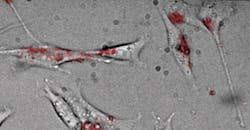Princeton, NJ and Berkeley, CA--Scientists have discovered how to use quantum dots to measure the temperature at different points within an individual living cell. The results, presented this week at the 242nd National Meeting & Exposition of the American Chemical Society (Aug. 25 to Sept. 1; Denver, CO), show that the temperature within a single cell can vary by up to a few degrees Fahrenheit.
Color of emitted light changes with temperature
Haw Yang, who is from Princeton University, and Liwei Lin, from the University California-Berkeley, inserted quantum dots in cells and monitored their emitted light. "We used quantum dots of cadmium and selenium that emit different wavelengths of light that correspond to temperature, and we can see that as a color change with our instruments," says Yang. The researchers used mouse cells growing in laboratory dishes.
“When one thinks about chemistry, temperature is one of the most important physical factors that can change in a chemical reaction," notes Yang. "So we really wanted to know more about the chemistry inside a cell, which can tell us more about how the chemistry of life occurs.”
Thousands of biochemical reactions are constantly underway inside cells, with some producing energy and heat. Parts of individual cells also may be warmer because they harbor energy-producing mitochondria. In addition to measuring temperatures, the scientists intentionally stimulated the cells in ways that boosted the biochemical activity within, observing the temperature changes. The temperature measurements are not yet accurate enough to produce exact numerical figures.
Yang says that such temperature changes may have bodywide impacts in determining health and disease, changing the way DNA and proteins function.
“This leads us to our next hypothesis, which is that cells may use differences in temperature as a way to communicate," he adds.

